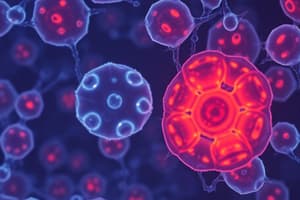Podcast
Questions and Answers
What is the primary focus of cell biology?
What is the primary focus of cell biology?
- The development of new cell culture techniques
- The analysis of DNA sequences
- The study of cell structure, function, and behavior (correct)
- The study of plant and animal morphology
What is the key difference between prokaryotic and eukaryotic cells?
What is the key difference between prokaryotic and eukaryotic cells?
- Prokaryotic cells have a membrane-bound nucleus, while eukaryotic cells do not. (correct)
- Prokaryotic cells have membrane-bound organelles, while eukaryotic cells do not.
- Eukaryotic cells are much smaller than prokaryotic cells.
- Eukaryotic cells lack a cell wall, while prokaryotic cells have a cell wall.
Which of the following is a technique used to study cells?
Which of the following is a technique used to study cells?
- Spectroscopy
- Gel electrophoresis
- Polymerase chain reaction (PCR)
- Microscopy (correct)
What is the typical size range of eukaryotic cells?
What is the typical size range of eukaryotic cells?
Which of the following is a key characteristic of prokaryotic cells?
Which of the following is a key characteristic of prokaryotic cells?
Which technique involves the use of fluorescent markers to visualize specific cellular components?
Which technique involves the use of fluorescent markers to visualize specific cellular components?
What does a flow cytometer primarily measure?
What does a flow cytometer primarily measure?
Which technique involves growing cells outside their natural environment for experimental purposes?
Which technique involves growing cells outside their natural environment for experimental purposes?
What is the primary purpose of cell fractionation?
What is the primary purpose of cell fractionation?
Which statement best describes the importance of cell biology?
Which statement best describes the importance of cell biology?
Flashcards are hidden until you start studying
Study Notes
Understanding Cell Biology: The Study of Cells and Their Functions
Cell biology is a branch of biology that focuses on the study of cell structure, function, and behavior. It encompasses both prokaryotic and eukaryotic cells, which have different characteristics but share fundamental aspects of cellular life. This field of study has many subtopics, including cell metabolism, cell communication, cell cycle, biochemistry, and cell composition.
Prokaryotic vs Eukaryotic Cells
Prokaryotic cells are found in bacteria and archaea. They lack an enclosed nucleus or other membrane-bound organelles. These cells are much smaller than eukaryotic cells and range from 1 to 3 micrometers (μm) in size.
Eukaryotic cells, on the other hand, are found in plants, animals, fungi, and protists. They have a membrane-bound nucleus and other membrane-bound organelles. These cells vary in size, ranging from 10 to 100 μm in diameter.
Studying Cells: From Light to Electron Microscopes
Scientists use various techniques to study cells and their structures. One of the most commonly used methods is microscopy.
-
Light Microscopy: Using light to visualize cells, phase-contrast microscopy shows the difference in refractivity between transparent objects. Confocal microscopy combines fluorescence microscopy with imaging to create three-dimensional images. Transmission electron microscopy involves using electrons to examine cells at high magnification.
-
Fluorescence Microscopy: This technique utilizes fluorescent markers like GFP to label specific components of cells, allowing for precise visualization.
-
Cytometry: A flow cytometer uses lasers to scatter cells based on physical and chemical properties. This method is useful for measuring the size, shape, and intracellular processes of cells.
-
Cell Culture: In vitro techniques involve growing cells outside their natural environment for experimental purposes. This method provides large quantities of specific cell types for research.
-
Cell Fractionation: By breaking up cells using high temperatures or sonification followed by centrifugation, scientists can separate various components of cells for further analysis.
These techniques have allowed researchers to understand how cells function at a molecular level, providing insights into health and disease mechanisms.
In conclusion, cell biology is a crucial part of understanding life at its most fundamental level. Through advanced technologies and techniques, scientists continue to explore the complex world of cells, leading to groundbreaking discoveries in medicine, biology, and beyond.
Studying That Suits You
Use AI to generate personalized quizzes and flashcards to suit your learning preferences.




